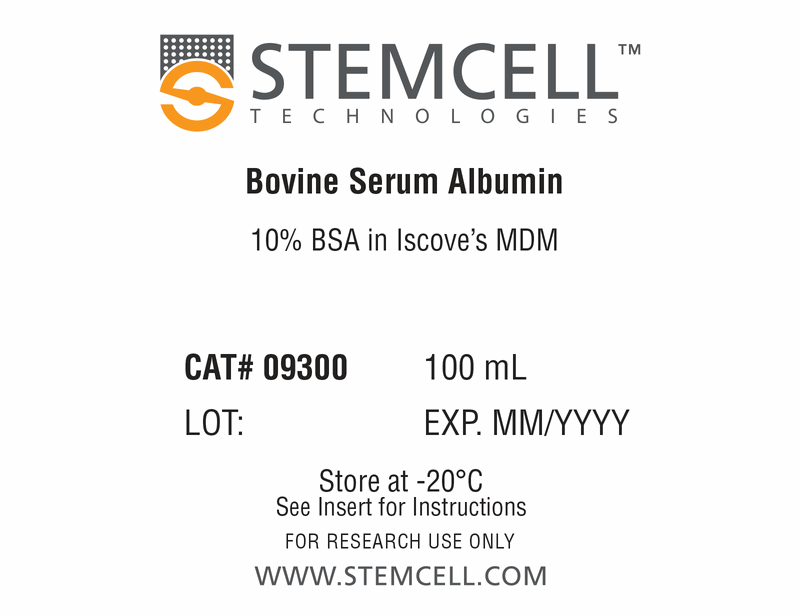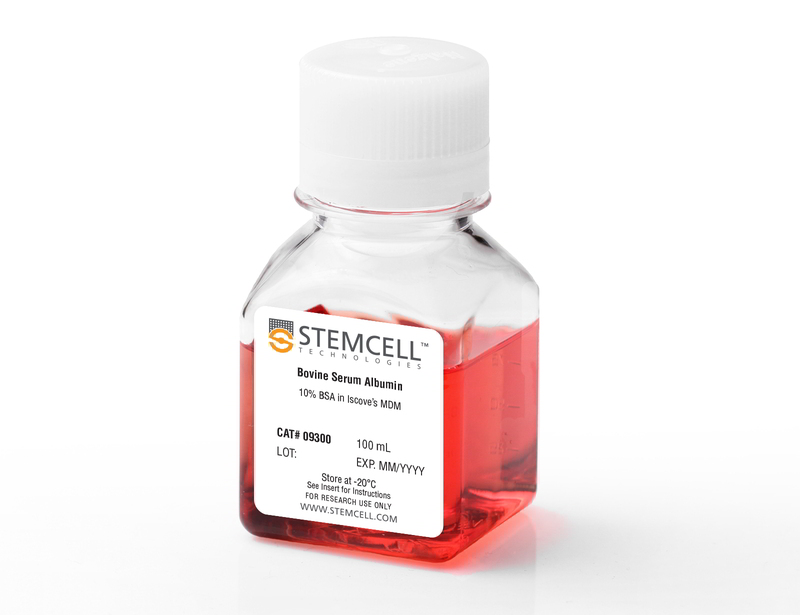10% Bovine Serum Albumin in Iscove's MDM
10% BSA in Iscove's MDM
概要
This product has been developed for use in applications where a culture medium of defined composition is required. It contains pre-screened batches of bovine serum albumin (BSA) that have been selected to support the optimal growth of human hematopoietic progenitor cells in serum-free media formulations. It is also suitable for the culture of mouse hematopoietic progenitor cells in serum-free conditions.
Recommended for use with MethoCult™ H4100 or MethoCult™ M3134 for hematopoietic colony-forming unit (CFU) assays (at a final concentration of 1%).
Recommended for use with MethoCult™ H4100 or MethoCult™ M3134 for hematopoietic colony-forming unit (CFU) assays (at a final concentration of 1%).
Contains
• Bovine serum albumin (10%)
• Iscove's MDM (buffered with NaHCO₃)
• Iscove's MDM (buffered with NaHCO₃)
Subtype
Basal Media
Cell Type
Hematopoietic Stem and Progenitor Cells, Other
Species
Human, Mouse
Application
Cell Culture
Formulation
Serum-Free
技术资料
| Document Type | 产品名称 | Catalog # | Lot # | 语言 |
|---|---|---|---|---|
| Product Information Sheet | 10% Bovine Serum Albumin in Iscove's MDM | 09300 | All | English |
| Manual | 10% Bovine Serum Albumin in Iscove's MDM | 09300 | All | English |
| Safety Data Sheet | 10% Bovine Serum Albumin in Iscove's MDM | 09300 | All | English |
数据及文献
Publications (11)
Nature 2015 JUN
PPAR-α and glucocorticoid receptor synergize to promote erythroid progenitor self-renewal.
Abstract
Abstract
Many acute and chronic anaemias, including haemolysis, sepsis and genetic bone marrow failure diseases such as Diamond-Blackfan anaemia, are not treatable with erythropoietin (Epo), because the colony-forming unit erythroid progenitors (CFU-Es) that respond to Epo are either too few in number or are not sensitive enough to Epo to maintain sufficient red blood cell production. Treatment of these anaemias requires a drug that acts at an earlier stage of red cell formation and enhances the formation of Epo-sensitive CFU-E progenitors. Recently, we showed that glucocorticoids specifically stimulate self-renewal of an early erythroid progenitor, burst-forming unit erythroid (BFU-E), and increase the production of terminally differentiated erythroid cells. Here we show that activation of the peroxisome proliferator-activated receptor α (PPAR-α) by the PPAR-α agonists GW7647 and fenofibrate synergizes with the glucocorticoid receptor (GR) to promote BFU-E self-renewal. Over time these agonists greatly increase production of mature red blood cells in cultures of both mouse fetal liver BFU-Es and mobilized human adult CD34(+) peripheral blood progenitors, with a new and effective culture system being used for the human cells that generates normal enucleated reticulocytes. Although Ppara(-/-) mice show no haematological difference from wild-type mice in both normal and phenylhydrazine (PHZ)-induced stress erythropoiesis, PPAR-α agonists facilitate recovery of wild-type but not Ppara(-/-) mice from PHZ-induced acute haemolytic anaemia. We also show that PPAR-α alleviates anaemia in a mouse model of chronic anaemia. Finally, both in control and corticosteroid-treated BFU-E cells, PPAR-α co-occupies many chromatin sites with GR; when activated by PPAR-α agonists, additional PPAR-α is recruited to GR-adjacent sites and presumably facilitates GR-dependent BFU-E self-renewal. Our discovery of the role of PPAR-α agonists in stimulating self-renewal of early erythroid progenitor cells suggests that the clinically tested PPAR-α agonists we used may improve the efficacy of corticosteroids in treating Epo-resistant anaemias.
Stem cells (Dayton, Ohio) 2007 JAN
In vitro expanded cells contributing to rapid severe combined immunodeficient repopulation activity are CD34+38-33+90+45RA-.
Abstract
Abstract
Expansion of hematopoietic stem cells could be used clinically to shorten the prolonged aplastic phase after umbilical cord blood (UCB) transplantation. In this report, we investigated rapid severe combined immunodeficient (SCID) repopulating activity (rSRA) 2 weeks after transplantation of CD34(+) UCB cells cultured with serum on MS5 stromal cells and in serum- and stroma-free cultures. Various subpopulations obtained after culture were studied for rSRA. CD34(+) expansion cultures resulted in vast expansion of CD45(+) and CD34(+) cells. Independent of the culture method, only the CD34(+)33(+)38(-) fraction of the cultured cells contained rSRA. Subsequently, we subfractionated the CD34(+)38(-) fraction using stem cell markers CD45RA and CD90. In vitro differentiation cultures showed CD34(+) expansion in both CD45RA(-) and CD90(+) cultures, whereas little increase in CD34(+) cells was observed in both CD45RA(+) and CD90(-) cultures. By four-color flow cytometry, we could demonstrate that CD34(+)38(-)45RA(-) and CD34(+)38(-)90(+) cell populations were largely overlapping. Both populations were able to reconstitute SCID/nonobese diabetic mice at 2 weeks, indicating that these cells contained rSRA activity. In contrast, CD34(+)38(-)45RA(+) or CD34(+)38(-)90(-) cells contributed only marginally to rSRA. Similar results were obtained when cells were injected intrafemorally, suggesting that the lack of reconstitution was not due to homing defects. In conclusion, we show that after in vitro expansion, rSRA is mediated by CD34(+)38(-)90(+)45RA(-) cells. All other cell fractions have limited reconstitutive potential, mainly because the cells have lost stem cell activity rather than because of homing defects. These findings can be used clinically to assess the rSRA of cultured stem cells.
Stem cells (Dayton, Ohio) 2006 OCT
Intracoronary infusion of CD133+ and CD133-CD34+ selected autologous bone marrow progenitor cells in patients with chronic ischemic cardiomyopathy: cell isolation, adherence to the infarcted area, and body distribution.
Abstract
Abstract
Central issues in intracoronary infusion (ICI) of bone marrow (BM)-cells to damaged myocardium for improving cardiac function are the cell number that is feasible and safe to be administrated as well as the retention of cells in the target area. Our study addressed these issues in eight patients with chronic ischemic cardiomyopathy undergoing ICI of selected BM-progenitors. We could immunomagnetically isolate 0.8 +/- 0.32 x 10(7) CD133(+) cells and 0.75 +/- 0.24 x 10(7) CD133(-)CD34(+) cells from 310 +/- 40 ml BM. After labeling these cells with (99m)Tc-hexamethylpropylenamineoxime, they were infused into the infarct-related artery without any complication. Scintigraphic images 1 (eight patients) and 24 hours (four patients) after ICI revealed an uptake of 9.2% +/- 3.6 and 6.8% +/- 2.4 of the total infused radioactivity in the infarcted area of the heart, respectively; the remaining activity was distributed mainly to liver and spleen. We conclude that through ICI of CD133(+) and CD133(-)CD34(+) BM-progenitors a significant number of them are preferentially attracted to and retained in the chronic ischemic myocardium.
Blood 1998 MAY
Efficient retroviral-mediated gene transfer to human cord blood stem cells with in vivo repopulating potential.
Abstract
Abstract
Recent studies have shown efficient gene transfer to primitive progenitors in human cord blood (CB) when the cells are incubated in retrovirus-containing supernatants on fibronectin-coated dishes. We have now used this approach to achieve efficient gene transfer to human CB cells with the capacity to regenerate lymphoid and myeloid progeny in nonobese diabetic (NOD)/severe combined immunodeficiency (SCID) mice. CD34(+) cell-enriched populations were first cultured for 3 days in serum-free medium containing interleukin-3 (IL-3), IL-6, granulocyte colony-stimulating factor, Flt3-ligand, and Steel factor followed by two 24-hour incubations with a MSCV-NEO virus-containing medium obtained under either serum-free or serum-replete conditions. The presence of serum during the latter 2 days made no consistent difference to the total number of cells, colony-forming cells (CFC), or long-term culture-initiating cells (LTC-IC) recovered at the end of the 5-day culture period, and the cells infected under either condition regenerated similar numbers of human CD34(+) (myeloid) CFC and human CD19(+) (B lymphoid) cells for up to 20 weeks in NOD/SCID recipients. However, the presence of serum increased the viral titer in the producer cell-conditioned medium and this was correlated with a twofold to threefold higher efficiency of gene transfer to all progenitor types. With the higher titer viral supernatant, 17% +/- 3% and 17% +/- 8%, G418-resistant in vivo repopulating cells and LTC-IC were obtained. As expected, the proportion of NEO + repopulating cells determined by polymerase chain reaction analysis of in vivo generated CFC was even higher (32% +/- 10%). There was no correlation between the frequency of gene transfer to LTC-IC and colony-forming unit-granulocyte-macrophage (CFU-GM), or to NOD/SCID repopulating cells and CFU-GM (r2 = 0.16 and 0.17, respectively), whereas values for LTC-IC and NOD/SCID repopulating cells were highly and significantly correlated (r2 = 0.85). These findings provide further evidence of a close relationship between human LTC-IC and NOD/SCID repopulating cells (assessed using a textgreater/= 6-week CFC output endpoint) and indicate the predictive value of gene transfer measurements to such LTC-IC for the design of clinical gene therapy protocols.
Blood 1997 MAY
Lack of expression of Thy-1 (CD90) on acute myeloid leukemia cells with long-term proliferative ability in vitro and in vivo.
Abstract
Abstract
Acute myeloid leukaemia (AML) is thought to be maintained by a small population of leukemic progenitor cells. To define the phenotype of such cells with long-term proliferative capacity in vitro and in vivo, we have used the production of leukemic clonogenic cells (CFU) after 2 to 8 weeks in suspension culture as a measure of these cells in vitro and compared their phenotype with that of cells capable of engrafting nonobese diabetic severe combined immune deficient (NOD/SCID) mice. Leukemic blast peripheral blood cells were evaluated for expression of CD34 and Thy-1 (CD90) antigens. The majority of AML blast cells at diagnosis lacked expression of Thy-1. Most primary CFU-blast and the CFU detected at up to 8 weeks from suspension cultures were CD34+/Thy-1-. AML cells that were capable of engrafting NOD/SCID mice were also found to have the CD34+/Thy-1- phenotype. However, significant engraftment was achieved using both CD34+/Thy-1- and CD34- subfractions from one AML M5 patient. These results suggest that while heterogeneity exists between individual patients, the leukemic progenitor cells that are capable of maintaining the disease in vitro and in vivo differ from normal hematopoietic progenitor cells in their lack of expression of Thy-1.
Proceedings of the National Academy of Sciences of the United States of America 1997 DEC
Expansion in vitro of adult murine hematopoietic stem cells with transplantable lympho-myeloid reconstituting ability.
Abstract
Abstract
Elucidation of mechanisms that regulate hematopoietic stem cell self-renewal and differentiation would be facilitated by the identification of defined culture conditions that allow these cells to be amplified. We now demonstrate a significant net increase (3-fold, P textless 0.001) in vitro of cells that are individually able to permanently and competitively reconstitute the lymphoid and myeloid systems of syngeneic recipient mice when Sca-1(+)lin- adult marrow cells are incubated for 10 days in serum-free medium with interleukin 11, flt3-ligand, and Steel factor. Moreover, the culture-derived repopulating cells continued to expand their numbers in the primary hosts at the same rate seen in recipients of noncultured stem cells. In the expansion cultures, long-term culture-initiating cells increased 7- +/- 2-fold, myeloid colony-forming cells increased 140- +/- 36-fold, and total nucleated cells increased 230- +/- 62-fold. Twenty-seven of 100 cultures initiated with 15 Sca-1(+)lin- marrow cells were found to contain transplantable stem cells 10 days later. This frequency of positive cultures is the same as the frequency of transplantable stem cells in the original input suspension, suggesting that most had undergone at least one self-renewal division in vitro. No expansion of stem cells was seen when Sca-1+TER119- CD34+ day 14.5 fetal liver cells were cultured under the same conditions. These findings set the stage for further investigations of the mechanisms by which cytokine stimulation may elicit different outcomes in mitotically activated hematopoietic stem cells during ontogeny and in the adult.


